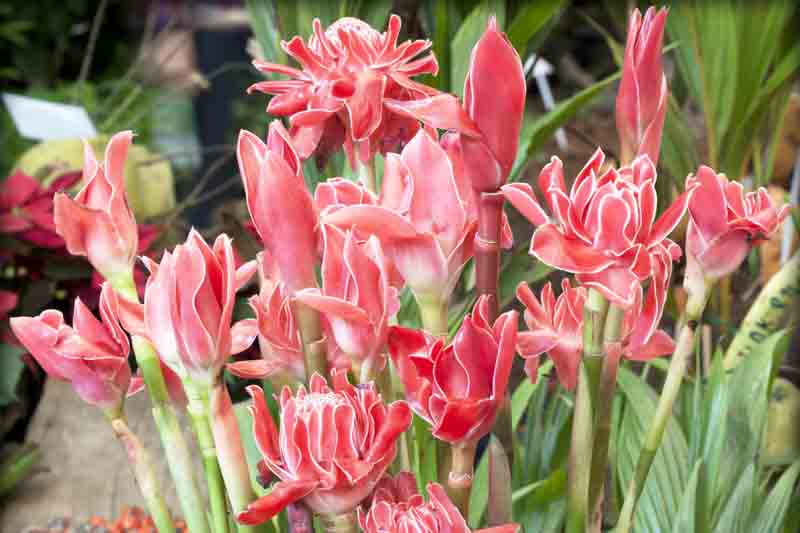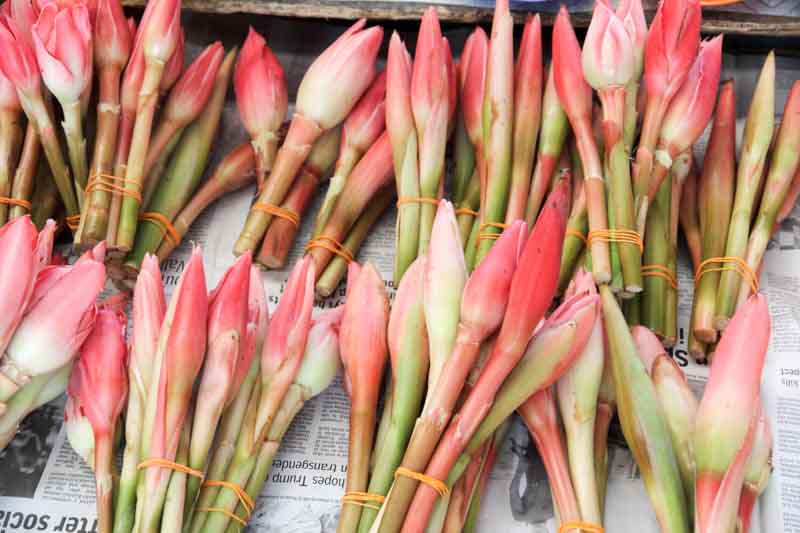Torch Ginger, Ginger Flower, Red Ginger Lily, Torchflower, Torch Lily, Wild Ginger
Etlingera elatior, commonly known as Torch Ginger or Red Ginger Lily, is a striking tropical plant renowned for its vibrant flowers and architectural foliage. This detailed overview explores its characteristics, cultivation, and uses.
Torch Ginger boasts tall, upright stems and large, lance-shaped leaves, culminating in spectacular, torch-like flower spikes. Its flowers, ranging from bright red to pink, emerge from colorful bracts, creating a dramatic display. Torch Ginger ranks as a top choice among tropical flowers.
Native: Native to Southeast Asia, including Malaysia, Thailand, and Indonesia, Torch Ginger thrives in humid, tropical environments, often in rainforest settings.
Plant Type and Habit: This tropical rhizomatous perennial is part of the ginger family, Zingiberaceae, featuring a clumping habit with pseudostems (stems made from tightly wrapped leaf bases) that grow directly from underground rhizomes.
Size: This plant features tall, upright pseudostems that can grow 6-15 feet tall (1.8 to 7.5 meters) in its native habitat, although it usually grows shorter in cultivation.
Flowers: The most distinctive feature of Torch Ginger is its remarkable inflorescence. The flower spikes emerge directly from the base of the plant, showcasing a stunning array of bright red, pink, or occasionally white bracts that resemble a flaming torch, hence the common name. Within these colorful bracts are small, actual flowers that are equally vibrant and attractive. Torch Ginger blooms periodically throughout the year in tropical climates, with each inflorescence lasting several weeks.
Foliage: The foliage is as striking and lush as its floral display. The plant features large, leathery, banana-like leaves that are rich, glossy green. These leaves can grow up to 3 feet long (90 cm).
Hardiness: It is hardy in USDA zones 10-12, requiring a frost-free climate to survive outdoors year-round.
Uses: While primarily grown for ornamental purposes, the flower buds of Torch Ginger are edible and used in Southeast Asian cuisine. It’s also utilized in traditional medicine and as a decorative element in floral arrangements.
Toxicity: There are no significant reports of toxicity to humans or pets, making it safe for cultivation in diverse settings.
Invasiveness: Not typically invasive due to its cultivation requirements and slow spread, but should be monitored in ideal growing conditions.
Benefits: Beyond its culinary and medicinal uses, Torch Ginger enhances landscape aesthetics with its exotic flowers and foliage, contributing to a tropical garden ambiance.

Growing and caring for Etlingera elatior (Torch Ginger) involves the following key considerations:
Light: Prefers full sun to light shade. However, it will appreciate some protection from the harsh afternoon sun, which can scorch the foliage.
Soil: Thrives in rich, well-draining soil with a slightly acidic to neutral pH. Amend soil with organic matter to improve fertility and drainage.
Water: Keep the soil consistently moist but not waterlogged. Reduce watering frequency during cooler months.
Temperature and Humidity: Etlingera elatior thrives in warm temperatures, ideally between 65°F to 85°F (18°C to 29°C), and high humidity levels, mimicking its native tropical environment. Protect from temperatures below 50°F (10°C) and provide extra humidity in dry indoor conditions.
Fertilization: Apply a balanced, slow-release fertilizer every few months during the growing season (spring to fall) to support lush growth and vibrant blooms.
Pruning: Remove spent flowers and dead leaves to encourage new growth.
Repotting: Repot Torch Ginger every 2-3 years or when it becomes root-bound. Choose a pot only slightly larger than the current one to avoid excess moisture retention in the soil. Use a well-draining, rich potting mix and repot in spring to give the plant time to establish before the growing season.
Propagation: Best propagated by division of rhizomes in late winter or early spring. Ensure each division has at least one growth bud.
Torch Ginger plants may encounter several pests, diseases, and common problems, especially when grown in less than ideal conditions.
Spider Mites: Indicated by fine webbing on the plant and tiny, moving dots (the mites), these pests thrive in dry conditions. Increase humidity and wash the plant with water or use miticides if necessary.
Mealybugs: These pests appear as small, white, cottony masses on leaves and stems, sucking sap and weakening the plant. Treat by dabbing with alcohol or applying insecticidal soap.
Scales: Hard or soft scales may attach to stems and leaves, also sucking sap. Remove manually or treat with horticultural oil.
Root rot: Overwatering or poorly draining soil can lead to fungal infections at the root level, causing the plant to wilt and potentially die. Ensure proper drainage and let the soil dry slightly between waterings.
Leaf spot: Caused by fungi or bacteria, presenting as discolored spots on leaves. Improve air circulation and reduce leaf wetness to manage this issue. Fungicides may be necessary for severe infections.
Leaf Burn: Direct sunlight can cause the leaves to scorch, leading to brown patches. Provide filtered light or shade during the hottest parts of the day.
Fading Flower Color: Insufficient light can lead to less vibrant blooms. Ensure your Torch Ginger receives adequate but indirect light to maintain flower color intensity.
Stunted Growth: Poor soil nutrition, compacted soil, or inadequate watering can restrict growth. Regular feeding with a balanced fertilizer during the growing season and ensuring the plant is not root-bound can help.

The flower buds of Etlingera elatior are culinary delights, offering edible enjoyment.
Etlingera elatior is commonly known as Torch Ginger due to its striking, torch-like flower spikes.
Etlingera elatior is not known to be poisonous. There are no widespread reports of toxicity to humans or pets from handling or ingesting parts of the plant.
Yes, parts of Etlingera elatior are edible. The flower buds are particularly used in Southeast Asian cuisine, adding a unique flavor to salads, soups, and other dishes.
In its native habitat, Etlingera elatior is not considered invasive. However, like many plants, it may become invasive in suitable climates outside its native range if it escapes cultivation and naturalizes in the wild. It’s always best to check local guidelines and regulations when planting non-native species.
Torch ginger (Etlingera elatior) is not considered toxic. It does not pose a known risk of poisoning to humans, pets, or wildlife when touched or ingested in small quantities.
| Hardiness |
10 - 12 |
|---|---|
| Plant Type | Perennials |
| Plant Family | Zingiberaceae |
| Exposure | Full Sun, Partial Sun |
| Season of Interest |
Spring (Early, Mid, Late) Summer (Early, Mid, Late) Fall Winter |
| Height |
6' - 15' (180cm - 4.6m) |
| Spread |
4' - 10' (120cm - 3m) |
| Maintenance | Low |
| Water Needs | Average |
| Soil Type | Loam, Sand |
| Soil pH | Acid, Neutral |
| Soil Drainage | Moist but Well-Drained |
| Characteristics | Showy, Evergreen |
| Garden Uses | Beds And Borders, Patio And Containers |
| Garden Styles | Mediterranean Garden |
| Hardiness |
10 - 12 |
|---|---|
| Plant Type | Perennials |
| Plant Family | Zingiberaceae |
| Exposure | Full Sun, Partial Sun |
| Season of Interest |
Spring (Early, Mid, Late) Summer (Early, Mid, Late) Fall Winter |
| Height |
6' - 15' (180cm - 4.6m) |
| Spread |
4' - 10' (120cm - 3m) |
| Maintenance | Low |
| Water Needs | Average |
| Soil Type | Loam, Sand |
| Soil pH | Acid, Neutral |
| Soil Drainage | Moist but Well-Drained |
| Characteristics | Showy, Evergreen |
| Garden Uses | Beds And Borders, Patio And Containers |
| Garden Styles | Mediterranean Garden |
How many Etlingera elatior (Torch Ginger) do I need for my garden?
| Plant | Quantity | |
|---|---|---|
| Etlingera elatior (Torch Ginger) | N/A | Buy Plants |
Create a membership account to save your garden designs and to view them on any device.
Becoming a contributing member of Gardenia is easy and can be done in just a few minutes. If you provide us with your name, email address and the payment of a modest $25 annual membership fee, you will become a full member, enabling you to design and save up to 25 of your garden design ideas.
Join now and start creating your dream garden!
Create a membership account to save your garden designs and to view them on any device.
Becoming a contributing member of Gardenia is easy and can be done in just a few minutes. If you provide us with your name, email address and the payment of a modest $25 annual membership fee, you will become a full member, enabling you to design and save up to 25 of your garden design ideas.
Join now and start creating your dream garden!